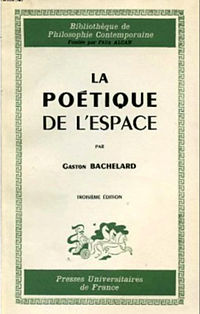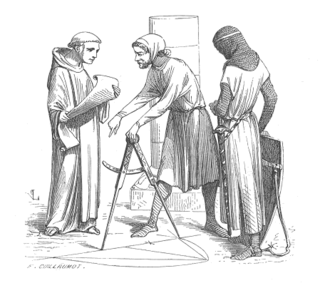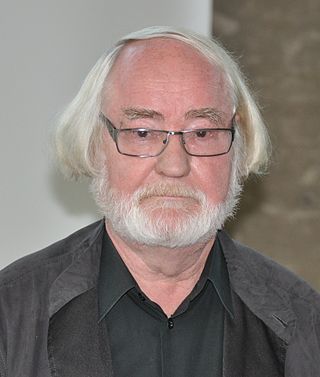Related Research Articles

Edmund Gustav Albrecht Husserl was an Austrian-German philosopher and mathematician who established the school of phenomenology.

Maurice Jean Jacques Merleau-Ponty was a French phenomenological philosopher, strongly influenced by Edmund Husserl and Martin Heidegger. The constitution of meaning in human experience was his main interest and he wrote on perception, art, politics, religion, biology, psychology, psychoanalysis, language, nature, and history. He was the lead editor of Les Temps modernes, the leftist magazine he established with Jean-Paul Sartre and Simone de Beauvoir in 1945.

Hermeneutics is the theory and methodology of interpretation, especially the interpretation of biblical texts, wisdom literature, as well as philosophical texts. As necessary, hermeneutics may include the art of understanding and communication.
Phenomenology is the philosophical study of objectivity – and reality more generally – as subjectively lived and experienced.
Neurophenomenology refers to a scientific research program aimed to address the hard problem of consciousness in a pragmatic way. It combines neuroscience with phenomenology in order to study experience, mind, and consciousness with an emphasis on the embodied condition of the human mind. The field is very much linked to fields such as neuropsychology, neuroanthropology and behavioral neuroscience and the study of phenomenology in psychology.
Existential phenomenology encompasses a wide range of thinkers who take up the view that philosophy must begin from experience like phenomenology, but argues for the temporality of personal existence as the framework for analysis of the human condition.

The Poetics of Space is a 1958 book about architecture by the French philosopher Gaston Bachelard. The book is considered an important work about art. Commentators have compared Bachelard's views to those of the philosopher Martin Heidegger.

Phenomenology of Perception is a 1945 book about perception by the French philosopher Maurice Merleau-Ponty, in which the author expounds his thesis of "the primacy of perception". The work established Merleau-Ponty as the pre-eminent philosopher of the body, and is considered a major statement of French existentialism.

Architectural theory is the act of thinking, discussing, and writing about architecture. Architectural theory is taught in all architecture schools and is practiced by the world's leading architects. Some forms that architecture theory takes are the lecture or dialogue, the treatise or book, and the paper project or competition entry. Architectural theory is often didactic, and theorists tend to stay close to or work from within schools. It has existed in some form since antiquity, and as publishing became more common, architectural theory gained an increased richness. Books, magazines, and journals published an unprecedented number of works by architects and critics in the 20th century. As a result, styles and movements formed and dissolved much more quickly than the relatively enduring modes in earlier history. It is to be expected that the use of the internet will further the discourse on architecture in the 21st century.
Dalibor Vesely was a Czech-born architectural historian and theorist who was influential through his teaching and writing in promoting the role of hermeneutics and phenomenology as part of the discourse of architecture and of architectural design.

Juhani Uolevi Pallasmaa is a Finnish architect and former professor of architecture and dean at the Helsinki University of Technology. Among the many academic and civic positions he has held are those of Director of the Museum of Finnish Architecture 1978–1983, and head of the Institute of Industrial Arts, Helsinki. He established his own architect's office – Arkkitehtitoimisto Juhani Pallasmaa KY – in 1983 in Helsinki. From 2001 to 2003, he was Raymond E. Maritz Visiting Professor of Architecture at Washington University in St. Louis, and in 2013 he received an honorary doctorate from that university. In 2010–2011, Pallasmaa served as Plym Distinguished Professor at the University of Illinois Urbana-Champaign, and in 2012-2013 he was scholar in residence at Frank Lloyd Wright's Taliesin. Pallasmaa has also lectured widely in Europe, North and South America, Africa and Asia.

"The Origin of the Work of Art" is an essay by the German philosopher Martin Heidegger. Heidegger drafted the text between 1935 and 1937, reworking it for publication in 1950 and again in 1960. Heidegger based his essay on a series of lectures he had previously delivered in Zurich and Frankfurt during the 1930s, first on the essence of the work of art and then on the question of the meaning of a "thing", marking the philosopher's first lectures on the notion of art.

Vittorio Gregotti was an Italian architect, born in Novara. He was seen as both a member of the Neo-Avant Garde and a key figure in 1970s Postmodernism.
Christian Norberg-Schulz was a Norwegian architect, author, educator and architectural theorist. Norberg-Schulz was part of the Modernist Movement in architecture and associated with architectural phenomenology.
John Sallis is an American philosopher well known for his work in the tradition of phenomenology. Since 2005, he has been the Frederick J. Adelmann Professor of Philosophy at Boston College. He has previously taught at Pennsylvania State University (1996–2005), Vanderbilt University (1990–1995), Loyola University of Chicago (1983–1990), Duquesne University (1966–1983) and the University of the South (1964–1966).
Nader El-Bizri is the Dean of the College of Arts, Humanities, and Social Sciences at the University of Sharjah. He served before as a tenured longstanding full Professor of philosophy and civilization studies at the American University of Beirut, where he also acted as an Associate Dean of the Faculty of Arts and Sciences, and as the Director of the General Education program. El-Bizri specializes in phenomenology, Islamic science and philosophy, and architectural theory. He is the author or editor of several books, including The Phenomenological Quest between Avicenna and Heidegger (2000).
David Leatherbarrow is Professor of Architecture and Chair of the Graduate Group in Architecture at the University of Pennsylvania School of Design, Philadelphia, where he has taught since 1984. He received his B.Arch. from the University of Kentucky and holds a Ph.D. in Art from the University of Essex. He has also taught in England, at Cambridge University and the University of Westminster.
In architecture, spatial design, literary theory, and film theory—affective atmosphere refers to the mood, situation, or sensorial qualities of a space. Spaces containing atmosphere are shaped through subjective and intersubjective interactions with the qualia of the architecture. Atmosphere is linked with anthropology, architectural theory, critical theory, cultural geography, phenomenology of architecture, and pragmatism.

Edward S. Casey is an American philosopher and university professor. He has published several volumes on phenomenology, philosophical psychology, and the philosophy of space and place. His work is widely cited in contemporary continental philosophy. He is currently Distinguished Professor of Philosophy at Stony Brook University in New York and distinguished visiting faculty at Pacifica Graduate Institute.
References
- ↑ Husserl, Edmund. Ding und Raum: Vorlesungen 1907. FelixMeiner Verlag GmbH. ISBN 3-7873-1013-4.
- ↑ Otero-Pailos, Jorge (2010). Architecture's Historical Turn: Phenomenology and the Rise of the Postmodern. University of Minnesota Press. p. 102. ISBN 9780816666041.
- ↑ Jorge Otero-Pailos, Theorizing the Anti-Avant-Garde: Invocations of Phenomenology in Architectural Discourse, 1945-1989, (Ph.D. Dissertation: Massachusetts Institute of Technology, 2001)
- ↑ Vittorio Gregotti and Jorge Otero-Pailos, "Interview with Vittorio Gregotti: The Role of Phenomenology in the Formation of the Italian Neo-Avant-Garde," in Thresholds, n. 21 (Fall 2000), 40-46
- ↑ Gaston Bachelard The Poetics of Space (1958)
- ↑ Maurice Merleau-Ponty's Phenomenology of Perception (English version 1962)
- 1 2 3 Baird, George (2018). "Phenomenology Upside Down: A Response to Log 42". Log (44): 15–25. ISSN 1547-4690.
- ↑ A Norwegian, he graduated from the Eidgenossische Technische Hochschule (ETH) in Zurich in 1949 and eventually became Dean of the Oslo School of Architecture.
- ↑ Mark Jarzombek—The Psychologizing of Modernity (Cambridge University Press, 2000).
- ↑ He also wrote Intentions in Architecture (1963)
- ↑ For example, Martin Heidegger's essay "Building Dwelling Thinking", 1951
- ↑ see Thomas Thiis-Evensen, Archetypes in Architecture (Oxford: Oxford University Press, 1987)
- ↑ Gallagher, Shaun; Dan Zahavi (2012). The phenomenological mind (2nd ed.). London: Routledge. ISBN 978-0-415-61036-0. OCLC 770694204.
- ↑ Barker, Heather Renée (2020). Designing post-virtual architectures: wicked tactics and world-building. New York. ISBN 978-1-315-63694-8. OCLC 1110679283.
{{cite book}}: CS1 maint: location missing publisher (link) - ↑ Schutz, Alfred (1972). The phenomenology of the social world. Evanston, IL: Northwestern University Press. ISBN 0-8101-0390-7. OCLC 35359357.
- ↑ "Building, Dwelling, Thinking" translated by Hofstadter, published in "poetry, Language, Thought", Harper Colophon Books, 1971. First published in German in 1954
- ↑
- Nader El-Bizri, "Being at Home Among Things: Heidegger's Reflections on Dwelling", Environment, Space, Place Vol. 3 (2011)pp. 47–71; and Nader El-Bizri, 'On Dwelling: Heideggerian Allusions to Architectural Phenomenology', Studia UBB Philosophia 60 (2015)pp. 5–30; also: Nader El-Bizri, 'Phenomenology of Place and Space in our Epoch: Thinking along Heideggerian Pathways', in The Phenomenology of Real and Virtual Places, ed. E. Champion (London : Routledge, 2018), pp. 123-143